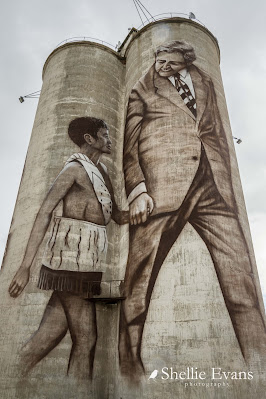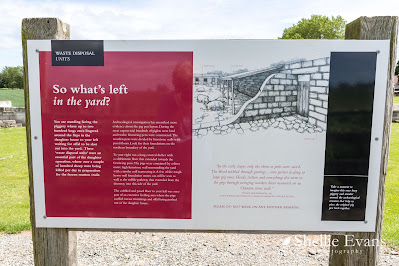I wanted to check out the murals on the sides of the Waimate Silos so I took myself on an afternoon tiki-tour. I thought I'd drive to Waimate 23kms away, then head up the Waitaki Valley, cross the river to Kurow and come back down the other side.
The last time we stopped in the area was way back in 2013 on our very first trip to the South Island, we stayed at the recently opened Waimate NZMCA Park and explored some of the area, including driving nearby Meyers Pass where I was very excited to see for the first time, a few spindly lupins in flower & another first, a dead wallaby!
And then when I looked around I could see why, I thought I'd better get my skates on, a massive dirty great black cloud was settling right over Waimate township.
I had just set off along the back of the loop when that big black cloud came back and dumped a solid sheet of rain on the town. Luckily I managed to scramble back to the ute and get inside just before it bucketed down.
The silos were a blank canvas back then, they have only recently been painted, in May 2018.
I stopped on the roadside on the way into Waimate to take some photos of a large wheat field. You can't see it in the photos but I love the rippling movement and the rustling of the wheat as the wind swishes the ripening stalks back & forth. I also spotted a flock of green finches having a feast in the middle of the field. They were very skittish, chattering as they tried to settle, then lifting off every few seconds as the wind spooked them.
Although by the time I got to town the dark brooding cloud had moved over to the hills behind.
Great I thought, I had time to walk the silo loop, a pedestrian loop that circles the outside of Transport Waimate's business premises and where you can view the murals, read all about them and not get in the way of the comings and goings of the businesses' stock trucks and other vehicles. Although I had to wait it out several times to capture a clean shot with no vehicles in the view.
The silo project was the idea of Transport Waimate's boss who commissioned Waimate artist, Bill Scott, to paint a number of local heroes on the silos. Click on the photo to read the history behind the silos & the people depicted in the murals.
I sat the rain out for 10 minutes or so and after it had passed returned to finish the pedestrian loop.
The next local hero was 'Big Norm', Norman Kirk, a former New Zealand Prime Minister (who is walking hand-in-hand with Moana Priest).
I wonder how many of you can recall where you were when you heard that Norman Kirk had died? I can. For some reason it has stuck in my head for over 45 years. I had just gained my drivers license and was allowed to take the family car, a Holden HQ stationwagon, from the farm down to our local shops to collect the Sunday paper (and Dad's Park Drive tobacco). Splashed across the paper's front page was the news of Norman Kirks sudden death. I remember being shocked and when I got home, running up the path and calling the news out to the others before I'd even got into the house.
And the last two figures are a tribute to two well respected local men that led by example; Michael Studholme & Chief Te Huruhuru.
There is another mural on the back wall of the silo buildings, one of another Waimate hero (heroine), Stella Chamberlain (a stellar lady?).
This was one incredible lady, click on the photo to read her story. Stella certainly deserves a medal not only for her 35 year dedication to the Waimate Rugby Club but for having 13 children of her own to look after too!
There are several more murals on the walls around town and I stopped to look at a few of them on my way to the next photo subject.
I couldn't believe my eyes when I pulled out back onto the main street, that big black cloud was heading our way again.
I'd taken photos of some of Waimate's historic buildings on my last visit but there was one I had overlooked, Quinns Arcade. I shot around the back of town and stopped to shoot the arcade as the cloud rumbled closer.
Quinns Arcade was built in 1906 from Makikihi bricks that were fired at William Quinn's brickworks, north of Waimate. The Arcadia included two dozen shops, twelve each side of a wide passage that led through to High Street. In 1920 Quinns Arcade became a picture theatre but it also didn't last very long.
I've photographed the magnificent St Patrick's Basilica before but thought I'd grab another shot before I headed back through town.
And that was when all hell broke loose. The cloud had moved right over the top of the town and started dumping massive great big hail stones on the main street. I pulled over as soon as I could as the noise on the ute was horrific and the wipers couldn't keep up.
The noise was ten times worse on top of the shop verandas, the road was covered and the gutters overflowing with melt water, solid lumps of ice and huge hail stones.
People came out from the shops and buildings to take photos & stare in wonder (or was it shock) at such a ferocious hail storm. I worried that the stones were going to smash the windscreen or dent the bonnet. The force was incredible & when I did move out from under cover to take a few photos, I ended up getting stung by hundreds of hail stones pinging me on the face, head & hands.
And then just like that, it was gone...
...leaving the street covered in a thick layer of icy ball bearings. It was amazing how many people still chose to drive through while the storm was raging. Really, you could not see more than a few feet in front of you, my wipers on full speed could not keep up, and the road was as slippery as.....well, ice.
Safe in the knowledge that the big black cloud was moving in the opposite direction I headed off up the Waitaki Valley, stopping for a brief look at the Waimate NZMCA Park on my way out of town...
...which looked one heck of a lot different to our stay there 6 years previous.
The Waimate Gorse...I mean Gorge, was an sea of yellow on both sides and right the way through. Once the land gets like this and the gorse takes over there's not much luck in returning it to native bush or grazing land. And seed from this lot would produce hundred of thousands more plants every season; what's that old adage, one year's seeds, 7 years weeds.
Uh-oh! Half way up the valley big fat icy blotches started pummeling the windscreen again.
And for the second time that day I had to pull over and sit out another terrific hail storm which had just as much intensity and power as the last one. It looked like the cloud had done another circuit. Afterwards I took some photos of a nearby ploughed paddock covered in ice and vehicle tracks in the ice. I was not far from a historic cob cottage (bottom left) which was built in 1880 from Penticotico clay & tussock. The hail stones lay on the grass path and around the cottage like snow.
As it turned out this was one day before a huge hail storm devastated Timaru (just 45kms north) leaving behind a $83 million insurance bill. Amongst the wide spread damage, car yards and vehicle dealerships had every vehicle on their yards dented and damaged. All I could think of was the local strawberry fields (which Waimate is well know for) with their ripening fruit.
I drove over the new Waitaki River bridge into Kurow and stopped for a cup of tea at a nearby rest area. The last time we crossed the river here the bridge was a rickety old one way bridge that looked to be about to collapse. If you check the link out at the beginning of this blog you'll see a photo of it.
From Kurow I headed down the valley on the other side of the river, stopping at the Takiroa rock art site, a historic Maori site where there are several drawings on the wall under an overhang of rock.
We've seen several Maori art sites in the district, including one on a private farm where we were staying. It was hard to make these ones out as they had been damaged before the protection fences had gone up.
There was one more place I wanted to check out before heading home. At Black Point I turned down a narrow pot holed farm track towards the river. I'm heading to Bortons Ponds, part of the Lower Waitaki Irrigation Scheme, where water is drawn from the river, held in the ponds and then distributed via canals to the Waitaki Plains. During peak season 1.4 million m3 of water passes through the scheme daily.
I'd heard about this place a very long time ago and if Mary is reading this now she'll kill me next time we cross paths. She spoke of it in very hushed tones and rather vaguely when I pressed her for more information. I don't miss much and I stored the name in the back of my memory box for next time we were in the area.
Mary and her friends (and other people in the know) freedom camp here around the ponds, there are several areas where you could camp (I can find no reference that you're not allowed but don't blame me if you get moved on) It's a very peaceful place and I'd imagine the locals come to picnic and swim here in the summer.
The scheme also supplies Oamaru with water so don't go peeing in it!
And that was that, it was time to move on. My beloved lupins were about to flower! Mackenzie Country was calling, Lake Tekapo here we come.




























































